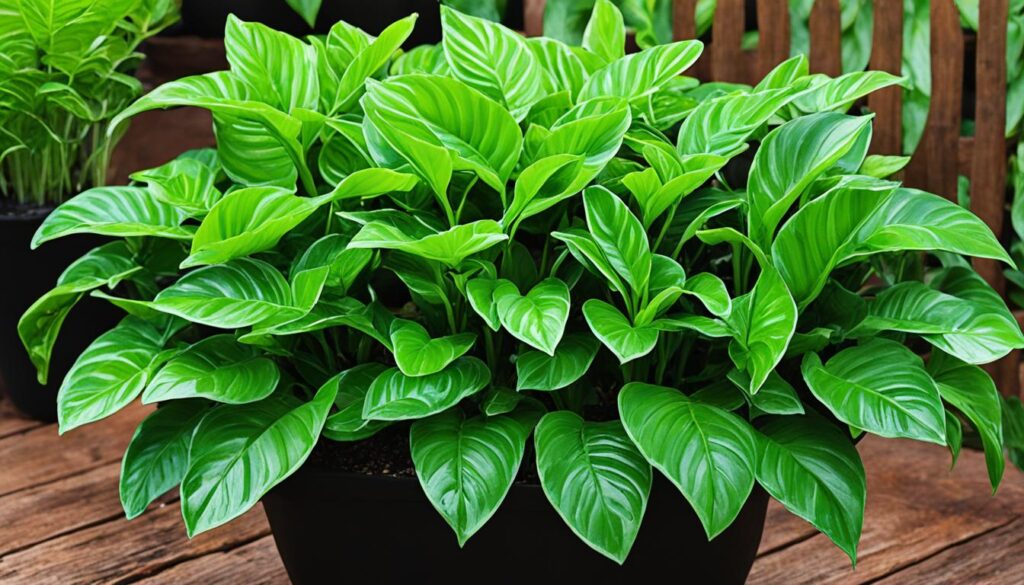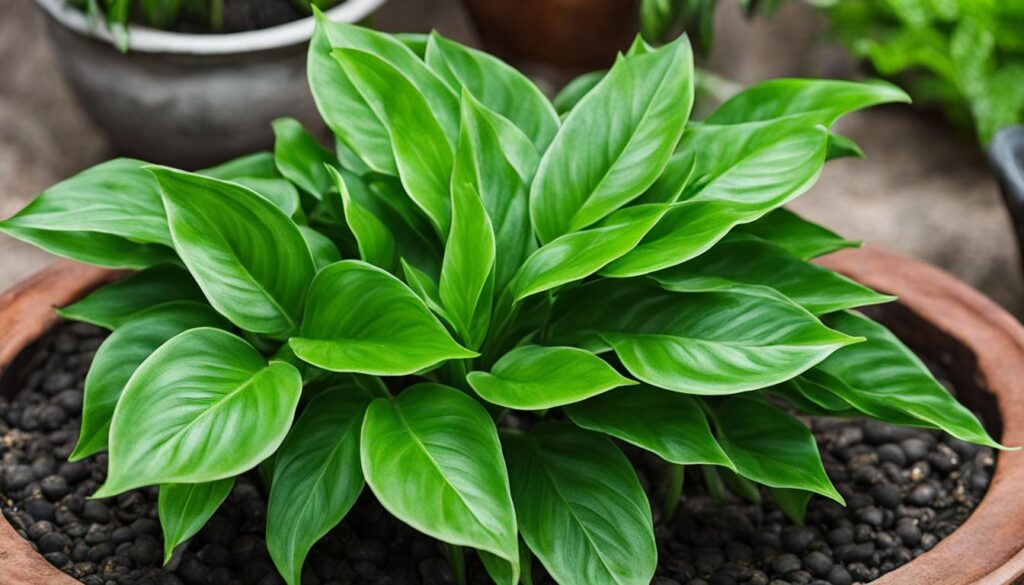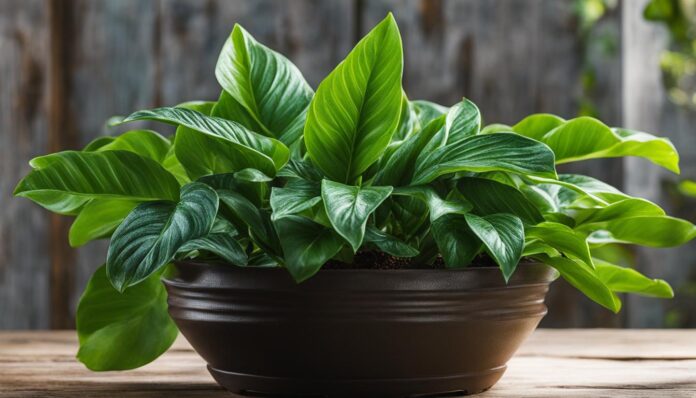The cast-iron plant, scientifically known as Aspidistra elatior, is a hard-to-kill and low-maintenance houseplant that thrives in low light conditions. It is a great choice for beginners and is known for its air-purifying qualities. This plant can survive neglect and various growing conditions that would harm other plants. It has arching, lance-shaped, glossy green leaves and can reach a height of 2-3 feet. The cast-iron plant is highly tolerant of low light, irregular watering, and a range of indoor temperatures. It is rarely bothered by pests or diseases and can be grown both indoors and outdoors. It prefers well-drained soil and should only be watered when the soil dries out. Direct sunlight should be avoided, as it can burn the leaves. This plant thrives in temperatures between 60 and 75 degrees Fahrenheit and is not cold-hardy. Fertilize monthly during the spring and summer months, and use a standard quality potting mix for container plants. Cast-iron plants can be propagated through division of the rhizome and should be repotted every 3-5 years. This plant rarely blooms, but when it does, the flowers are small and insignificant.
Key Takeaways:
- The cast-iron plant, also known as Aspidistra elatior, is a hardy and low-maintenance houseplant that thrives in low light conditions.
- It is a great choice for beginners and is known for its air-purifying qualities.
- The cast-iron plant can survive neglect and various growing conditions that would harm other plants.
- It is highly tolerant of low light, irregular watering, and a range of indoor temperatures.
- This plant rarely blooms, but when it does, the flowers are small and insignificant.
Description of the Cast Iron Plant
The cast-iron plant, also known as the bar room plant, is a perennial and herbaceous plant belonging to the Asparagaceae family. Its botanical name is Aspidistra elatior. This plant is native to Asia and is highly valued for its resilient nature and ease of care. It has long, lance-shaped leaves that are deep green and glossy. The leaves can grow up to 2 feet long and 4 inches wide.
When planted outdoors, the cast-iron plant can produce cream and purple flowers near the base of the plant, but these flowers are usually not seen when the plant is grown indoors.
The cast-iron plant has a slow growth rate and can grow faster when exposed to more light, but direct sunlight can burn its leaves. This plant is known for its tolerance to low light conditions and can handle deep shade. It is typically not bothered by insects or diseases and is always green, making it a popular choice for areas with minimal sunlight, such as under deck stairs or along foundations.
Cast Iron Plant Care Requirements
In order to keep your Cast Iron Plant (Aspidistra elatior) healthy and thriving, it is important to follow its specific care requirements. By providing the right conditions, you can ensure that your low light plant remains vibrant and beautiful.
Watering
The Cast Iron Plant prefers slightly dry conditions and has a tolerance for drought. It’s important to avoid overwatering, as this can cause root rot. Water the plant only when the top inch of soil feels dry to the touch. This will prevent waterlogging and ensure optimal root health.
Sunlight
The Cast Iron Plant thrives in low light conditions and should be kept away from direct sunlight, which can burn its leaves. It prefers indirect sunlight or shade. Find a spot in your home that receives low to moderate light, such as a north-facing window or a room with minimal direct sunlight.
Temperature
The Cast Iron Plant prefers temperatures between 60 and 75 degrees Fahrenheit. It is not cold-hardy and should be brought indoors if the temperature drops below 50 degrees Fahrenheit. This plant can tolerate a range of indoor temperatures and is well-suited for most home environments.
Soil
The Cast Iron Plant can tolerate a wide range of soils as long as they have good drainage. It prefers well-drained soil with a slightly acidic to neutral pH. When repotting, use a standard potting mix with good drainage properties to ensure optimal root health.
Humidity
The Cast Iron Plant can tolerate low humidity levels, making it suitable for indoor environments with dry air. However, it can benefit from occasional misting or wiping of the leaves with a damp cloth to maintain optimal humidity levels. This will prevent the leaves from drying out and becoming brittle.
Fertilization
Feed your Cast Iron Plant with an all-purpose liquid fertilizer once a month during the spring and summer months. Follow the instructions on the fertilizer label for proper dilution and application. Avoid over-fertilization, as this can lead to nutrient burn. Fertilizing regularly will promote healthy growth and vibrant foliage.
Pruning
Pruning is important to maintain the overall appearance of your Cast Iron Plant. Remove any yellow or brown leaves to keep the plant looking fresh and healthy. Use clean, sharp pruning shears to make clean cuts and avoid damaging the plant.
Propagation
The Cast Iron Plant can be propagated through division of the rhizome. When the plant has outgrown its pot or needs rejuvenation, carefully remove the plant from its pot and separate the rhizomes, making sure each division has several leaves. Plant the divisions in separate pots with fresh potting mix, and water thoroughly. The new plants will establish roots and continue to grow.
| Care Requirement | Details |
|---|---|
| Watering | Water when the top inch of soil is dry; avoid overwatering to prevent root rot. |
| Sunlight | Indirect light or shade; avoid direct sunlight to prevent leaf burn. |
| Temperature | 60-75°F (15-24°C); protect from temperatures below 50°F (10°C). |
| Soil | Well-drained soil with a slightly acidic to neutral pH. |
| Humidity | Tolerates low humidity levels; occasional misting or wiping of leaves with a damp cloth can help maintain humidity. |
| Fertilization | Feed monthly with an all-purpose liquid fertilizer during the spring and summer. |
| Pruning | Remove yellow or brown leaves to maintain overall appearance. |
| Propagation | Divide rhizomes and plant in separate pots with fresh potting mix. |
By following these care requirements, you can enjoy a thriving Cast Iron Plant that adds beauty to your indoor space.

Light Requirements for the Cast Iron Plant
The cast-iron plant, a popular choice for indoor gardens, thrives in low light conditions. Its ability to tolerate low light levels makes it an excellent choice for areas with limited sunlight. While it can handle some direct sunlight, it’s important to avoid placing it in bright, sunny spots as excessive exposure to direct sun can burn its leaves. When positioning your cast-iron plant, aim for a location that provides indirect light, such as a north-facing window.
Placing your cast-iron plant near a north-facing window will ensure it receives sufficient light without the risk of leaf burn. North-facing windows allow soft, indirect light to filter through, creating an ideal environment for this low light plant. If a north-facing window is not available, you can also consider placing your cast-iron plant in rooms with south- or west-facing windows that don’t receive excessive sunlight.
If you decide to grow your cast-iron plant outdoors, it’s essential to select a shady area that offers indirect sunlight. Direct sun exposure can be detrimental to the plant’s health, causing leaf damage and stress. When choosing an outdoor location for your cast-iron plant, prioritize areas with partial shade or filtered sunlight to protect it from the intense rays of the sun.
Soil and Watering Requirements for the Cast Iron Plant
The robust and low-maintenance Cast Iron Plant thrives in a variety of soil types but prefers well-drained soil to prevent waterlogging and root rot. Sandy, loamy, and clay soils are all suitable for this resilient plant.
Watering is a crucial aspect of Cast Iron Plant care. It is important to maintain a balance between keeping the soil moist and avoiding overwatering. Wait until the top inch of soil feels dry to the touch before watering the plant. This plant has a remarkable drought tolerance and can withstand periods of dry soil, making it an excellent choice for busy plant parents.
Pro Tip: Avoid overwatering the Cast Iron Plant, as it can lead to root rot. Only water the plant when the soil is dry to protect its health and overall well-being.
During the initial growing season, regular watering is necessary to establish a robust root system. However, once the Cast Iron Plant is well-established, it requires less frequent watering.
To help you keep track of the watering schedule, we’ve prepared a handy table outlining the suggested watering frequency for the Cast Iron Plant based on its growth stage:
| Growth Stage | Watering Frequency |
|---|---|
| Establishment (First year) | Water when the top inch of soil dries out |
| Mature plant (After the first year) | Water sparingly when the soil becomes dry |
This stunning image showcases the beauty of the Cast Iron Plant while highlighting its lush foliage. A visual treat for all plant enthusiasts!
Temperature and Humidity Requirements for the Cast Iron Plant
When it comes to temperature, the cast iron plant thrives in a moderate range. It prefers temperatures between 60 and 75 degrees Fahrenheit, making it suitable for most indoor environments. However, it is important to note that the cast iron plant is not cold-hardy. If the temperature drops below 50 degrees Fahrenheit, it should be brought indoors to protect it from cold damage.
One of the reasons the cast iron plant is so popular as an indoor plant is its ability to tolerate low humidity levels. It can thrive in environments with dry air, making it a great choice for homes and offices with lower humidity. That being said, the cast iron plant can benefit from occasional misting or wiping of the leaves with a damp cloth. This helps to create a slightly more humid microclimate around the plant, which can be beneficial, especially in drier environments.
Overall, the cast iron plant is a resilient and adaptable indoor plant that can handle a range of temperatures and humidity levels. Its ability to thrive in low light, tolerate irregular watering, and withstand dry air makes it an ideal choice for those looking for a low-maintenance and cold-hardy indoor plant.
| Temperature Requirements | Humidity Requirements |
|---|---|
| 60-75 degrees Fahrenheit | Can tolerate low humidity levels, but benefits from occasional misting or wiping of the leaves |
| Not cold-hardy; should be brought indoors if temperature drops below 50 degrees Fahrenheit | – |
Fertilization and Pruning of the Cast Iron Plant
The cast-iron plant, known for its low-maintenance nature, requires minimal fertilization. It is not a heavy feeder, making it an ideal houseplant for those seeking a low-commitment plant. Fertilization is recommended once a month during the spring and summer months. An all-purpose liquid fertilizer can be used to provide the necessary nutrients for healthy growth. The fertilizer should be applied after watering to prevent root burn.
When it comes to pruning, the cast-iron plant generally does not require extensive trimming. However, it is important to remove any yellow or brown leaves to maintain the plant’s overall appearance and health. Pruning can be done using clean, sharp scissors or pruning shears. Be sure to make clean cuts to prevent any damage or infection to the plant.
Benefits of Fertilization:
Proper fertilization of the cast-iron plant can offer several benefits:
- Promotes healthy growth
- Enhances leaf color and vibrancy
- Strengthens the plant’s overall resilience
- Supports the production of new leaves
Benefits of Pruning:
Regular pruning of the cast-iron plant offers the following benefits:
- Maintains the plant’s aesthetic appeal
- Prevents the spread of diseases or pests
- Eliminates dead or dying foliage
- Encourages the growth of new, healthy leaves
Remember, the cast-iron plant is a hardy and forgiving plant that can tolerate neglect. However, providing it with the proper care, including fertilization and pruning, can help it thrive and maintain its beauty over time.

Propagation and Repotting of the Cast Iron Plant
The cast-iron plant, also known as Aspidistra elatior, can be easily propagated through division of the rhizome. To propagate, choose a healthy rhizome with at least two or three leaves.
It is important to select a pot with good drainage and fill it with fresh potting mix before planting the rhizome. Place the pot in an area with indirect sunlight and water the new plant regularly, ensuring the soil remains slightly moist but not waterlogged.
Repotting the cast-iron plant should be done every 3-5 years to provide it with fresh soil and enough space for its growth. Choose a slightly larger pot than the previous one to accommodate the expanding root system.
To repot the plant, gently remove it from its old pot, being careful not to damage the roots. Place it in the new pot, add fresh potting mix around the roots, and gently pat it down to secure the plant.
Steps for Propagation and Repotting of the Cast Iron Plant
| Propagation | Repotting |
|---|---|
| Select a healthy rhizome with 2-3 leaves | Choose a slightly larger pot |
| Plant in a pot with good drainage and fresh potting mix | Gently remove the plant from its old pot |
| Keep in indirect sunlight | Place in the new pot with fresh potting mix |
| Water regularly to establish a strong root system | Add fresh potting mix around the roots |
Common Issues and Troubleshooting for the Cast Iron Plant
The cast-iron plant is a resilient and low-maintenance houseplant, but it can occasionally encounter some common issues. One of the most common problems is yellowing or browning leaves. This can be caused by overwatering, underwatering, or exposing the plant to too much direct sunlight. To resolve this issue, it’s important to check the moisture level of the soil before watering and adjust the watering frequency accordingly. Avoid placing the plant in direct sunlight to prevent leaf burn.
Drooping leaves can also be a concern for cast-iron plants. This is usually a sign of dryness and indicates that the plant needs a drink of water. Make sure to water the plant when the top inch of soil feels dry to the touch. Keeping the plant adequately hydrated will help prevent drooping leaves.
While the cast-iron plant is generally resistant to pests and diseases, it can still be affected by common houseplant pests such as mites and scale. If you notice any signs of infestation, such as webbing or tiny insects on the leaves, you can rinse the foliage with water or use an insecticidal soap to control the pests. For more severe infestations, it’s recommended to seek the advice of a professional or use a horticultural oil.
FAQ
What is the cast iron plant?
The cast iron plant, scientifically known as Aspidistra elatior, is a hard-to-kill and low-maintenance houseplant that thrives in low light conditions. It is also known as the bar room plant.
What are the care requirements for the cast iron plant?
The cast iron plant requires indirect sunlight, well-drained soil, and regular but infrequent watering. It prefers temperatures between 60 and 75 degrees Fahrenheit and is not cold-hardy.
Can the cast iron plant tolerate low light conditions?
Yes, the cast iron plant thrives in low light conditions and is well-suited for indoor environments with minimal sunlight.
How often should I water the cast iron plant?
The cast iron plant should be watered only when the top inch of soil feels dry to the touch. It has a tolerance for drought and can withstand periods of dry soil.
Can I place the cast iron plant in direct sunlight?
Direct sunlight should be avoided, as it can burn the leaves of the cast iron plant. It prefers indirect sunlight or low light conditions.
How often should I fertilize the cast iron plant?
The cast iron plant does not require frequent fertilization. It can be fertilized once a month with an all-purpose liquid fertilizer during the spring and summer months.
How do I propagate the cast iron plant?
The cast iron plant can be propagated through division of the rhizome. A healthy rhizome with at least two or three leaves should be selected and planted in a pot with good drainage and fresh potting mix.
What are some common issues with the cast iron plant?
Common issues with the cast iron plant include yellowing or browning leaves, which can be caused by overwatering, underwatering, or too much sunlight. It is generally not prone to pest or disease problems.
How often should I repot the cast iron plant?
Repotting should be done every 3-5 years, using a slightly larger pot than the previous one. The plant should be gently removed from its old pot and placed in the new pot with fresh potting mix.

